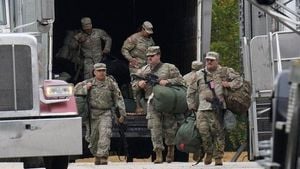On May 5, 2025, Laos is facing significant challenges in its export sector, attributed largely to rising tariffs implemented by the United States under former President Donald Trump. According to Xaybandith Ladphone, the Minister of Industry and Commerce, Laos has been particularly impacted by these tariffs, which are among the highest in Southeast Asia, reaching 48%. This places Laos second only to Cambodia in terms of tariff burdens.
In a recent report by the Agence France-Presse, Ladphone emphasized the urgency of the situation, stating that the Lao government is collaborating with various stakeholders to analyze the implications of these tariffs on the nation's exports. The bilateral trade between Laos and the U.S. was valued at approximately $500-600 million last fiscal year, largely due to increased activity in special economic zones.
However, the outlook for the Lao manufacturing sector is grim. Ladphone warned that the new tariff policies could threaten employment and slow down investment if production activities come to a halt. He noted that the trade relationship between Laos and the U.S. has been built on years of development and mutual trust, but it may take considerable time and resources to establish alternative market relationships.
Meanwhile, in Thailand, the export landscape is showing signs of robust growth. The value of Thai exports in March 2025 surged by 17.8% year-on-year, reaching $29.55 billion USD, the highest growth rate in three years. This growth was driven by a strong demand for electronics, particularly computers and their components, which saw increases of 107.2% and 44.4%, respectively.
The Thai economy has benefited from increased production and export activities ahead of the anticipated U.S. retaliatory tariffs. Exports to the U.S. alone grew by 34.3%, reflecting a strategic push to capitalize on existing trade relationships before potential disruptions occur. Exports to China also rose by 22.2%, showcasing the resilience of Thai products in global markets.
Despite the positive figures, experts at SCB EIC caution that the second half of 2025 may present challenges. The anticipated slowdown in export growth is attributed to the impact of U.S. trade policies, which are expected to include a 10% increase in tariffs across a broad range of products starting April 9, 2025. This shift may lead to a significant contraction in Thai exports, with projections indicating a potential decline of 0.4% for the entire year.
As Thailand navigates these turbulent waters, it is crucial to note that the country's reliance on the U.S. market—accounting for 18.3% of total exports—exposes it to vulnerabilities associated with trade barriers. The SCB EIC has highlighted that Thailand may face a reciprocal tariff rate of up to 36%, significantly higher than the global average.
In light of these developments, the Thai government is keenly aware of the need to adapt its trade strategies. The SCB EIC's recent assessments indicate that the global economy is expected to grow at a sluggish pace of 2.2% this year, down from previous estimates. The World Trade Organization (WTO) and the International Monetary Fund (IMF) have also revised their global trade volume forecasts downwards, suggesting a contraction of -0.2% for 2025.
In a related context, Sri Trang Agro-Industry Public Company Limited, a major player in Thailand's rubber industry, has taken proactive measures to ensure stability within the sector. The company's Managing Director, Weerasit Sincharoenkul, confirmed that the firm has sufficient stock to maintain production and exports despite the recent request from the Rubber Authority of Thailand to delay rubber tapping by one month.
Weerasit emphasized that the collaboration between public and private sectors is vital for economic stability in Thailand. He stated, "Customers in both domestic and international markets place importance on confidence. If a company has high confidence, strong relationships, and good collaboration with customers, it will help increase sales rapidly." This sentiment reflects the broader theme of maintaining trust and reliability in trade relationships amidst uncertainty.
Furthermore, the Thai government is working closely with various stakeholders to facilitate trade and ensure compliance with international standards, especially in the wake of potential changes in U.S. trade policies. The focus on sustainability and governance practices within the agricultural sector is also gaining traction, with companies like Sri Trang leading the way.
As the situation evolves, both Laos and Thailand are poised to face the ramifications of shifting trade dynamics. Laos must navigate the immediate challenges posed by increased tariffs, while Thailand seeks to strengthen its export capabilities and mitigate the impacts of U.S. trade policies. The coming months will be critical for both nations as they adapt to the changing landscape of international trade.





